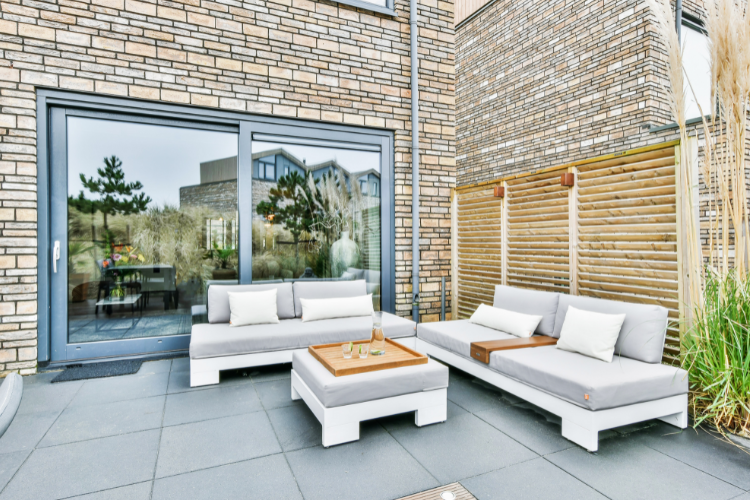
The Impact of Salt Air on Outdoor Furniture and How to Prevent Damage
Posted by Zing Patio on Jun 24th 2025
Living in coastal Florida offers breathtaking ocean views, warm breezes, and year-round outdoor living. But for patio furniture, that salt-laced air can be an unforgiving enemy.
Whether you're relaxing beachside in Naples, hosting pool parties in Sarasota, or enjoying sunset dinners in Fort Myers, your furniture is constantly exposed to a corrosive cocktail of humidity and salt.
Understanding how salt air affects patio materials—and how to protect your investment—can save you time, money, and frustration.
Here’s how to keep your outdoor space stylish and functional, even in Florida’s harshest conditions.
Why Salt Air Is So Damaging
Salt air contains microscopic particles of saltwater carried by the wind from the ocean. These particles settle on outdoor surfaces and attract moisture from the humid air. This cycle leads to:
- Corrosion of metals (especially iron, steel, and low-grade aluminum)
- Discoloration or staining on fabrics and wood
- Accelerated degradation of paint, finishes, and woven materials
The damage isn't always immediate. Often, it appears over time—starting with surface dullness, rust spots, or mildew—until it eventually affects the integrity of your furniture.
Choose Salt-Air-Resistant Materials

The first line of defense is material selection. Not all patio furniture is made to handle the salty air of Florida’s coasts. Here are your best bets:
1. Powder-Coated Aluminum
Aluminum is naturally rust-resistant, but salt air can still corrode exposed joints or chips in the finish. Powder-coated aluminum creates a tough, sealed surface that resists chipping and offers excellent longevity in coastal climates.
2. Marine-Grade Stainless Steel (316)
Unlike 304 stainless, marine-grade 316 includes molybdenum, which helps resist salt corrosion. It’s ideal for those who love a modern metal look without constant maintenance.
3. Teak and Ipe Wood
These tropical hardwoods are naturally resistant to moisture, insects, and decay. Teak in particular contains natural oils that help it withstand salty conditions. However, regular cleaning and oiling are recommended to maintain appearance.
4. HDPE Resin Wicker
Synthetic wicker made from high-density polyethylene won’t fade, crack, or absorb moisture. It’s molded to look like traditional wicker but performs far better in humid and salty environments.
Avoid: Untreated iron, basic steel, and cheap plastic
These materials can quickly corrode, discolor, or crack when exposed to salt air. Even painted finishes won’t last long if the underlying material is not built for the coast.
Use Protective Finishes and Sealants
Even if your furniture is made from durable materials, applying the right treatments can extend its lifespan.
- Marine-grade wax or polish can create a protective barrier on metal and wood.
- Fabric sealants designed for outdoor use help repel saltwater and dirt on cushions and umbrellas.
- Wood oil treatments (like teak oil) replenish natural oils and slow graying or cracking.
Be cautious: Not all sealants are compatible with every material. Always follow the manufacturer’s guidelines or ask a specialist—such as the experts at Zing Patio—for personalized advice.
Clean Regularly—Even If It Looks Clean
Salt air damage often begins long before you see visible changes. A simple maintenance routine can make all the difference.
- Weekly wipe-downs with fresh water help remove salt residue before it corrodes.
- Monthly deep cleans using mild soap and a soft brush can help keep grime and salt buildup under control.
- Pressure washing should be used sparingly and only on materials that can handle it—avoid high-pressure streams on wicker, soft woods, or cushions.
If your furniture lives in an uncovered area, increasing your cleaning frequency during Florida’s stormier seasons is essential.
Cover and Store Smartly
One of the most effective ways to minimize salt damage is through proper storage and coverage.
- Use waterproof, breathable covers when furniture is not in use, especially overnight.
- Elevate items off the ground to avoid puddles and prevent moisture buildup.
- Store cushions indoors when storms or prolonged humidity are in the forecast.
Zing Patio offers custom-fit covers for many of its collections, designed specifically for Florida’s humid and salty climate.
Your Local Furniture Experts in Naples, Fort Myers, and Sarasota
At Zing Patio, we understand the unique challenges coastal Florida presents. Our showrooms in Naples, Fort Myers, and Sarasota carry a curated selection of outdoor furniture crafted for resilience and style.
We help customers find pieces that don’t just look beautiful—but stand up to the elements year after year.
Whether you're revamping a lanai near the beach or protecting a high-rise balcony from ocean spray, our team can guide you to the best choices for coastal living.
 Top Brands, Extensive Selection
Top Brands, Extensive Selection  Guaranteed Lowest Prices
Guaranteed Lowest Prices 
